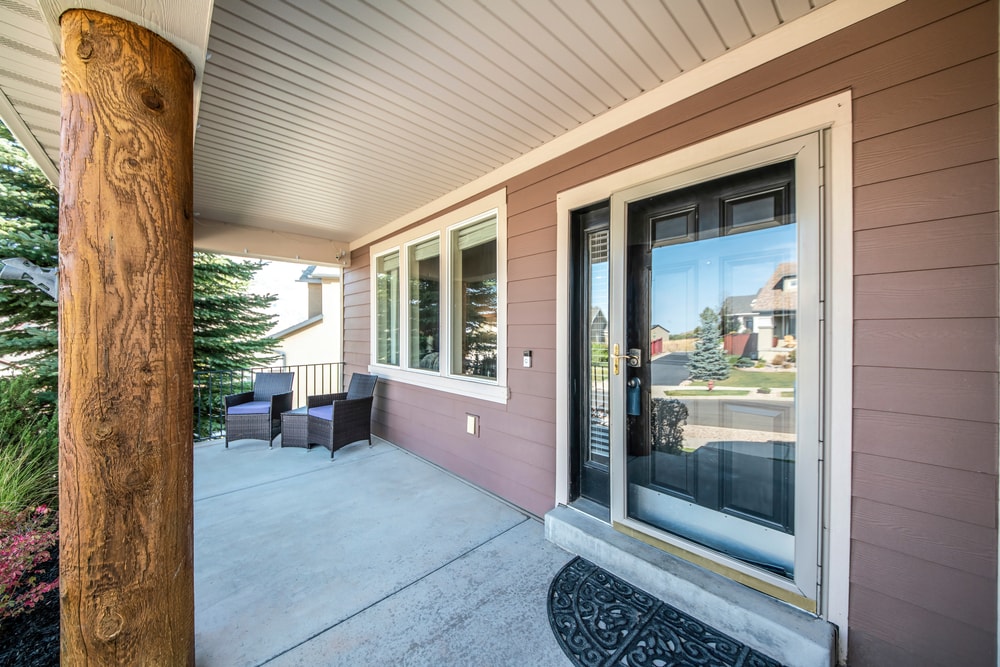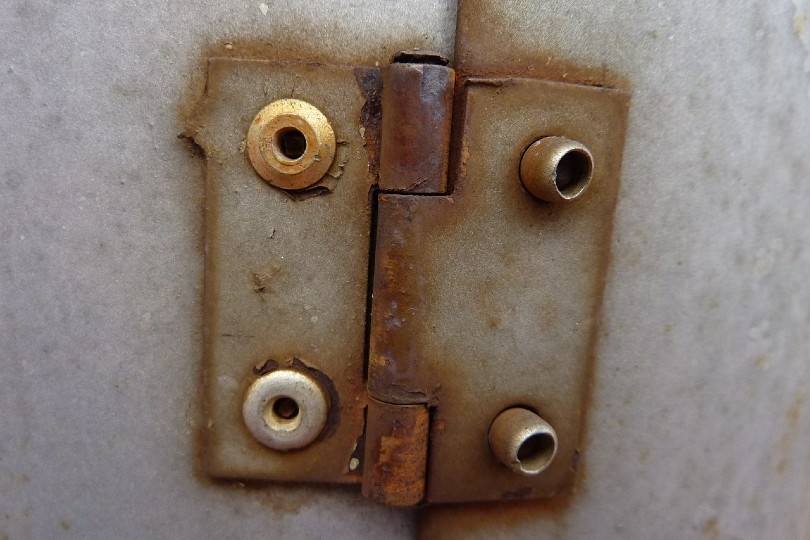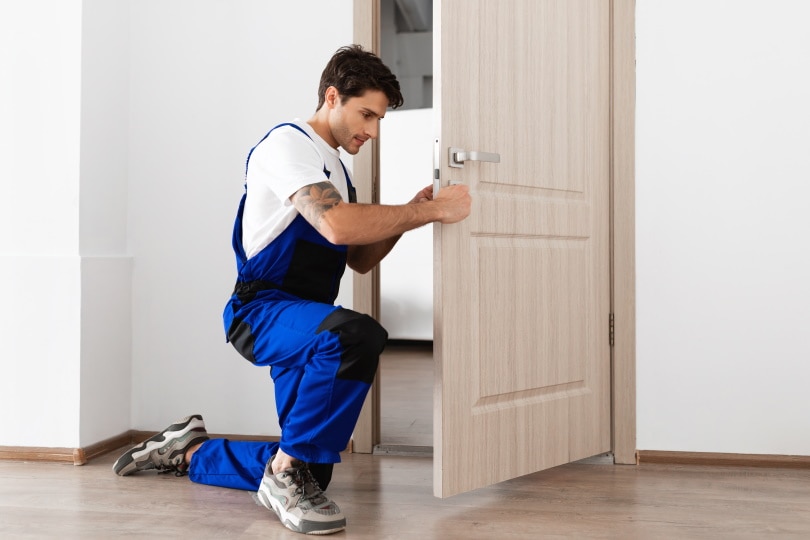How to Measure for a Storm Door In 4 Steps
-
Pete Ortiz
- Last updated:

Are you thinking of getting a storm door? If yes, that’s a great idea. But, how do you know what size you need? What if the storm door you buy doesn’t fit into the opening?
Storm doors are an excellent way to spruce up your home and crank up energy efficiency. Whether you want to improve the security and comfort of your home or add a bit of curb appeal to your house, storm doors are an excellent investment.
But before you run out and buy one, you’ll need to know how to measure for a storm door and take specific measurements to get a suitable door. In this article, we will show you several easy steps how to measure a storm door. This way, your new storm door will fit just right!
 Determining the Need for a Storm Door
Determining the Need for a Storm Door
A storm door is a traditional exterior door with an internal protective screen. It blocks drafts like you wouldn’t believe.
With the bonus of moving the storm door around if need be, they make your home more energy-efficient. The storm door also keeps flies and mosquitoes out.
To determine if your home requires a storm door, examine the trim around your exterior door. If it extends beyond the door jamb, you don’t need a storm door. If the trim stops before it reaches the jamb, you will need one.
A good rule of thumb is that if you can see light or hear noise between your exterior door and its frame when closed, you need a storm door.
The trim should always be:
- 3/4-inch wide
- Be in perfect shape
- Have a 1-inch depth
- Have 2 ½ inches of unimpeded clearance from the exterior door
Check for rotting wood and if there is any damage to the trim. If there’s rotting wood, you need to repair it before installing a storm door. You can use a small block plane to remove the rotten area. Then, coat the exposed wood with wood glue or apply some clear caulk.

Tools Needed to Measure for a Storm Door
- A step ladder or a stool
- Tape measure
- A pen and a notebook

Step-By-Step Guide for Measuring for a Storm Door
So, how do you measure for a storm door? There are many ways, but here are the most common. We’ll keep it short and sweet, so grab a pen and a notebook and let’s get started!

1. Inspect That You Have Sufficient Space to Attach the Storm Door
Measuring a storm door can be tricky. You need to find out if you have enough space for the door in your exterior wall and the opening space on the inside of your home.
Before starting, make sure you have enough room to mount the door. In most cases, you should install the door within a few inches of the front of the opening. It allows for easy access.
Use a tape measure to measure from the outside edge of your current storm door frame. Then, measure the inside edge of the wall where you’re planning to install the new storm door.
If there is not enough room, consider relocating or replacing hardware, such as doorknobs, hinges, or handles. They might interfere with the proper operation of the weatherproof storm door.
2. Measure the Door’s Width
To measure the width of a storm door, use a tape measure. The measurement you take will be the overall width. Measure across the inside of the frame, making sure you are measuring in a place where the frame is still square and not bowed out or drooping.
The measurement you take should be from the left to the right top inside edge of the door trim. It will give you the width of your opening, also known as your rough opening. Repeat this procedure at the middle and bottom of the doorway.
You may have different measurements when you measure at the top, middle, and bottom because of the warping of the doorframe. You’ll have a more accurate measurement by measuring all three locations.
If your door’s frame is bowed, measure it at two to four points along its length to find the widest point. It will help ensure you get a door that fits well.
If your door has a screen, measure from side to side of the opening—don’t include space for a screen in your measurement. Note down these measurements.

3. Measure the Door’s Height
When measuring for a storm door, you’ll want to measure the height from the top of the threshold (where it meets the floor) to the bottom of the door. Note down these measurements also.
The height of the storm door is important because it affects how your door will mount to the house, the space that it takes up on the exterior of your home, and if it will close well. That is why it’s important that you take its measurement.
Also, you don’t have to duck your head when entering or leaving your house. If you cannot stand completely straight, your storm door will be too low, and you may need to consider a taller model.
4. Round Off These Measurements to Full Figures
Always round off the measurements to whole numbers before ordering a door. The extra inch or two that you might save by not rounding can throw off the fit of the door and make it challenging to install.
For instance, if you’ve found the height is 34 1/2 inches, you can round it off to 35 inches. The reason for doing this is that many storm doors are available in standard sizes. When buying a storm door, the manufacturer needs full dimensions.
Let’s now look at how you can choose a suitable storm door for you and the different storm door styles available.

How to Choose a Suitable Storm Door
A storm door is attached to your house. It covers the existing door completely. It adds an extra layer of insulation to the home, and it’s also great for outdoor living.
After measuring for a storm door, you need to decide what type of storm door you want.
Storm doors are available in a wide range of colors. The available colors include glossy, matte, white, bronze, and even printable colors. The colors can match your front door, or they can be a complete contrast if you so desire.
Storm doors are also available in either wooden or metal frames. A wooden frame will look similar to your existing front door, while a metal frame will have a more contemporary look.
Whichever frame you choose, it should have the same style as the rest of your entryway.
Different Styles of Storm Doors
There are different styles of storm doors available, and each serves a purpose. All you have to do is choose one that will work for your home or business. Also, decide on the type that will fit the function you need it for.
The right door can make a huge difference when it comes to adding aesthetic value and functionality to your home. Here are several storm door styles that you can choose from.
Full View Storm Door
The storm door provides a clear view of the outdoors while keeping out the elements. It is perfect for homes in floodplains or close to water bodies. Homeowners can enjoy the views without worrying about damaging water coming through the door.
Also, it’s great for homes in northern climates where you want to let in as much sunlight and fresh air as possible but need protection from the cold.
Usually, a full view storm door consists of four panels that slide open on a track. This way, you can step out onto your porch or walkway.
Roll Screen or Retractable Storm Door
These are the most modern designs. Retractable or roll screen storm doors consist of two units, each with a track. The door unit includes the door, a locking mechanism, and a weather seal. The screen unit is the retractable screen that rolls up and down in the track.
The biggest advantage of retractable or roll-up storm doors is accessibility. They are easy to use, and you can open them from either side. But you just need to open one side of your door to get access to your home or garage. It means that you don’t have to crawl over furniture or reach through a storm door while standing outside in bad weather. Also, it gives you more control over privacy and security.
The biggest disadvantage is potential damage from high winds due to the thin screens used in these doors. You can prevent this by adding heavy-gauge screen materials.
Ventilating Storm Door
A ventilating storm door has a bottom half, top half, and glass panel in between. It allows the bottom part to open up like a regular door, while the top part opens from above by sliding it up.
Usually, a ventilating storm door is used for entryways with doors that swing both ways. It gives the option of closing off the door completely or just the screen section of it. You can leave the screen section open. It allows fresh air into your home without letting in bugs or other animals.
The biggest benefit of a ventilating storm door is its versatility. It gives you the option of having a regular solid wood or metal storm door or one with a screen section.
Frequently Asked Questions on Storm Doors
What is a storm door’s standard size?
The standard size for a storm door is 36″ by 80″ or 80″ by 36″. It includes the frame and the glass.
The storm door has a screen insert. It’s made to fit inside the frame of the storm door. The screen insert measures 36″ by 60″. You can cut the screen insert to fit smaller openings.
What is a Z-bar, and how is it used?
A Z-bar is a metal bar that attaches to the bottom of a storm door. Sometimes, it’s called a threshold bar or shoe. You can use a Z-bar to reduce the width of the rough opening by ½ an inch or a full 1-inch. A Z-bar is mounted on the brick mold before installing the storm door.
The Z-bar also creates a seal that prevents outside air from entering your home when the storm door is closed. It also serves as a stop for the door. This way, it doesn’t swing too far inward and hit the main door frame.
The Z-bar does not seal tightly against the floor and has gaps on either side. They allow for expansion. Without it, air can get in between the storm door and the wall of your home during hot or cold weather.
What is the difference between a storm door and a screen door?
A storm door is an exterior door that protects from the elements such as wind, rain, snow, and so on. It also helps to insulate the interior of your house by preventing air infiltration. It is attached to the frame of your existing door using hinges. But it slides into place above the other door when closed.
Usually, the storm door is made of wood, although vinyl and fiberglass are also used. It’s hinged on either the left or right side. So, it swings into place either in front of or behind an existing exterior door. The storm door can be left open when you want to let fresh air into your home and protect against bugs at the same time.
A screen door is designed to keep insects out while allowing airflow through the screen mesh. Screen doors are most often connected to an exterior doorway with hinges. They swing into place behind an entryway when opened. Screen doors are usually made of aluminum or wood.
 Conclusion
Conclusion
Before you go out and buy your storm door, make sure you’re getting the right fit for your house. Do your research and find out what the typical storm door sizes are. Then, measure your door before making the purchase.
It will save you time and help ensure a more accurate fit. Storm doors can be an excellent way to add value to your home. But, it’s only if you buy the correct size.
As with most home improvement projects, always read the instructions on the packaging to avoid damaging the product.
With these guidelines in mind, you should have no trouble making sure that you select the right size for your new storm door.
Featured Image Credit: Jason Finn, Shutterstock
Contents

 Determining the Need for a Storm Door
Determining the Need for a Storm Door
